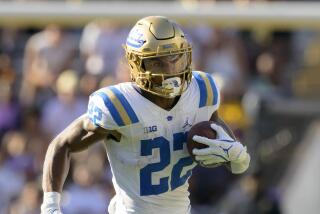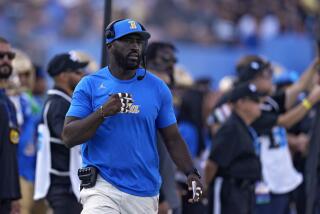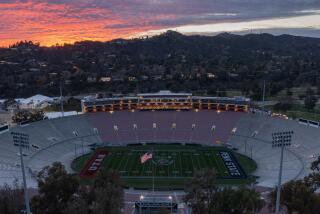It’s Truly Home Away From Home
WANTED: Stadium on the Westside, 55-60K seats, state-of-the-art amenities, ample parking and access. Tenant available. Call Peter Dalis, UCLA, 9 a.m.-5 p.m.
If you build it, they will come.
If you don’t, they will keep going back to the Rose Bowl because it’s the only place in town for UCLA--even if it’s out of town.
It’s UCLA’s own, after a fashion, and 12 years ago it offered a friendly alternative to playing third-fiddle at the Coliseum. UCLA offered revenue, which Pasadena quickly became accustomed to, turning the most famous stadium in the United States from a monument to a profit center.
The sticking point in the UCLA-Rose Bowl relationship is something no one can do anything about: Pasadena likes the stadium right where it is. UCLA would prefer to have it located in Westwood.
In the last two years, Peter Dalis, the school’s athletic director, has talked to two groups with designs on a stadium near LAX, but no ground has been broken, no paper has been signed and no real hope has arisen for finding a place to play football closer to the UCLA campus.
Yes, the Coliseum is closer. No, UCLA doesn’t want to play there, but it bothers Dalis that every other year, the Bruins play a road game against USC that is 10 miles closer to Westwood than UCLA’s home stadium.
“It’s 25 miles from campus,” he said of the Rose Bowl. “We’re the only university in the United States that has to drive 25 miles to play a home game.”
Along the Ventura Freeway, Dalis figures, UCLA loses attendance, season tickets and anything resembling a home-field advantage for its football team.
Still, it is theirs. The Bruins have played in Pasadena since 1982, after yet another bout with the Coliseum Commission convinced them of permanent stepchild status.
“It was increasingly difficult to play Division I-A football there with two schools,” Dalis said. “When I was a student, one of them sometimes had to play on Friday night. People forget that.
“Besides, I consider the Coliseum on the USC campus.”
And when the Rams moved to Anaheim Stadium, UCLA officials figured that the Bruins had at least moved up to No. 2, knowing USC would always be No. 1 in the hearts, minds and wallets of the Coliseum Commission.
Then the Raiders moved in, and it was back to No. 3 for UCLA in getting Coliseum dates. That served to hasten the Bruins’ departure for Pasadena.
“That first year, we increased season-ticket sales from 17,000 to 22,000,” Dalis said. “The advantages to playing in the Rose Bowl are not sharing it with anyone else, and it has a grand tradition. It’s got very good sight lines. But there are disadvantages.”
One is that it has more than 100,000 seats, which makes UCLA football the easiest ticket in town.
“There is no incentive to get a ticket early,” Dalis said. “Supply and demand related to a 100,000-seat stadium is different than with a smaller facility.”
To stimulate ticket demand, UCLA has to supply victories, and when the Bruins didn’t do so earlier in this decade, demand for tickets waned. Season-ticket sales are up 2,000 after a championship season, to about 28,000. Dalis figures that an on-campus or a Westside stadium would add thousands to that figure.
But Dave Jacobs isn’t so sure.
“People in Southern California are well programmed to travel much greater distances than 25 miles for entertainment,” the Rose Bowl’s general manager said. “What we hear is that one of the things UCLA alumni like about our facility is that they can come here and tailgate in an area that’s as serene and beautiful as the Arroyo Seco--and as safe as the Arroyo Seco.”
The implication that it’s safer than South Central Los Angeles and the Coliseum is clear.
After eating off their tailgates in the Arroyo Seco, apparently the alumni call Dalis.
“We get a lot of complaints from our ticket-holders about getting in and out of the place, the restrooms and concession stands,” he said. “It’s an old stadium. The press box is good, but there is no theater-type seating, and concession areas and restrooms aren’t state of the art.”
It’s a 72-year-old stadium, but Pasadena is enjoying a new gold strike.
When UCLA moved to the Rose Bowl, the City Council passed the Arroyo Seco Ordinance to assure homeowners that their neighborhood stadium wouldn’t be overused after decades of a New Year’s Day bowl game, Thanksgiving Day high school game between Pasadena and Muir, the odd Super Bowl and regular swap meets.
The law requires approval of the homeowners for the Rose Bowl to operate more than 12 days a year when attendance at an event will be greater than 20,000.
Apparently, that approval is frequently given. This year, there will be 25 events, including seven World Cup games, two Rolling Stones concerts, two days of Pink Floyd and one of the Eagles. And six UCLA games.
“This year, for the first time, revenues were taken from the Rose Bowl account to offset expenses city-wide,” Jacobs said. “As an example, of the $2 million we received for the World Cup, more than $1 million was taken to pay for new costs of law enforcement. In the past, we just had to pay for operating expenses. Now, we’re being looked at as a profit center.”
The profit from UCLA football pales next to that from Pink Floyd and other such events. UCLA pays 8% of ticket revenue and 8% of live television, plus a fixed sum for expenses, and Dalis estimates that Pasadena will receive between $400,000 and $500,000 this season from the Bruins.
According to Jacobs, the city will realize about $200,000 from UCLA after expenses. The net will be $1.5 million to $2 million from the five rock concerts.
But Pasadena and its still-in-development Rose Bowl Operating Co., a nonprofit firm set up to generate a profit for the city, likes the idea of UCLA playing in the Rose Bowl. It adds prestige and a consistent source of revenue, and its fans rarely cause trouble.
“And we feel we have an enormous economic impact on the city of Pasadena,” Dalis said. “Look at the restaurants after a game. It’s really difficult to get into a restaurant or a bar.”
So, they need each other. Two attempts to get an on-campus stadium failed--in the 1960s and ‘70s--and now the cost is prohibitive. Also, homeowners in Bel-Air and adjacent affluent communities probably are too powerful to allow UCLA to play football in their neighborhood.
Dalis’ talks with the two Westside stadium groups have gone nowhere, and he acknowledges that without an NFL team as its No. 1 tenant, a stadium is unlikely to be built.
UCLA’s contract with the Rose Bowl runs through the 1996 season, and in about a year negotiations will begin to extend it. Those talks will probably take on a harder line, concerning the profit demands of the city, a more businesslike approach to its facility and a new issue: paid parking at the Arroyo Seco. Free parking has always been part of the allure of the Rose Bowl.
Dalis describes UCLA’s relationship with Pasadena as increasingly tense.
“Sometimes, I wonder if they really want us there,” he said.
He acknowledges that the university’s demands are increasing, but calls them reasonable and said Jacobs works hard to meet them.
A recent move by the Rose Bowl to put a sign on a tarpaulin covering seats behind the UCLA bench, making it visible to television cameras, hasn’t helped. UCLA figures it is due money from the advertising, but the city and the school can’t agree on the split. Lawyers have been called in to review the contract, and Jacobs points out that UCLA displays a sign touting an airline at its games, which helps it obtain a discount on charter flights.
Jacobs describes the relationship with UCLA as good and adds that the Rose Bowl is working to meet those increasing demands.
“But the bottom line is cutting the best deal for Pasadena,” he said. “We really have a partnership with UCLA where we try to look out for their needs, keeping in mind the responsibility of making the best deal possible for the city.”
Dalis would prefer a partnership with somebody like the Raiders’ Al Davis for a stadium on the Westside. Until then, he, like others, will pack for the drive to Pasadena.
More to Read
Go beyond the scoreboard
Get the latest on L.A.'s teams in the daily Sports Report newsletter.
You may occasionally receive promotional content from the Los Angeles Times.






